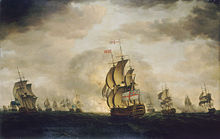Francis Holman
Francis Holman | |
|---|---|
 Francis Holman Painting of Commodore James in HCS Protector, with HCS Revenge and the HCS grab Bombay in the bay off the Suvarnadug fort at Gheriah, India, April 1755 | |
| Born | 1729 |
| Died | 29 November 1784 (aged c. 55) |
| Nationality | British |
| Known for | Marine art |
| Notable work | Views of London shipyards and river traffic, and naval actions, for example:
|
Francis Holman (1729–1784) was a British maritime painter, little recognised during his own lifetime, but whose paintings are now sought after. He is also notable as the teacher of Thomas Luny.
Life
He was born in



Francis Holman lived in at least five addresses in
Work
Holman's earliest works are portraits of ships, commonly commissioned for ships'
With the
Fate
Holman died in Wapping on 29 November 1784. Captain John Holman brought his body back to Ramsgate for burial on 4 December in Jane's family vault at St Laurence, where the vicar recorded his death as due to "lethargy".[1]
Artistic achievement
According to Lionel Cust in the Dictionary of National Biography, Holman's work "met with unmerited neglect".[1] More recently, his paintings have achieved good prices at auction and form significant collections at museums, not least the National Maritime Museum. His attention to detail and in-depth knowledge of his subject have left us with a valuable record of eighteenth century maritime life, and consequently his reputation as a major marine painter has grown. His importance as the teacher of Thomas Luny has also enhanced his reputation.[2]
References
- ^ a b c d e f g The Dictionary of National Biography, Oxford University Press, 2004–2008
- ^ a b "Francis Holman biography". National Maritime Museum. Archived from the original on 4 August 2007. Retrieved 2 September 2008.
Bibliography
- A Dictionary of British Marine Painters, Arnold Wlison, A & C Black Publishers Ltd, 1970, ISBN 0-85317-051-7
- The Dictionary of 18th Century British Painters, ISBN 0-902028-93-6
